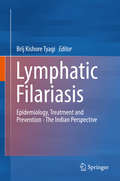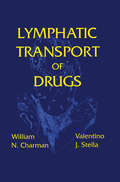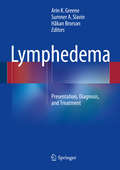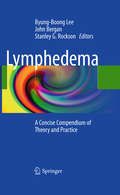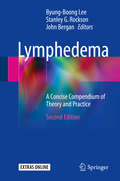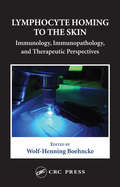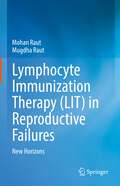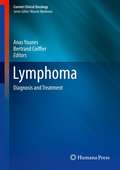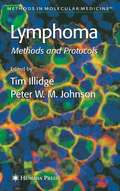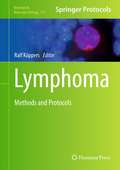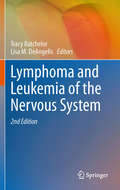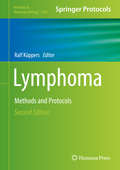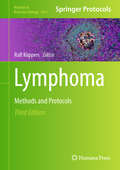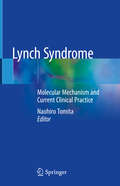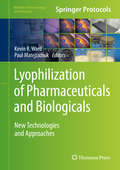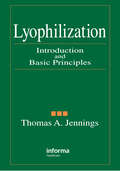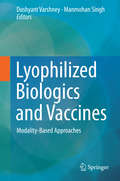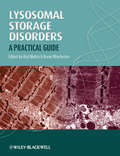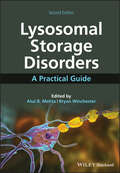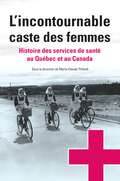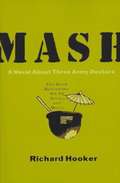- Table View
- List View
Lymphatic Filariasis: Epidemiology, Treatment And Prevention - The Indian Perspective
by Brij Kishore TyagiLymphatic Filariasis (LF) is a group of human and animal infectious diseases caused by nematode parasites of the order Filariidae. Often neglected, it is one of the oldest and the most debilitating tropical diseases (NTDs), transmitted from human to human by mosquitoes bites, particularly the brown black mosquito known as Culex quinquifasciatus. LF is a major public health problem in many parts of the tropics, especially India, which accounts for as much as 40% of total global cases. As a leading cause of permanent and long-term disability worldwide, the parasite infection imposes a severe physical and socioeconomic burden. The World Health Organization (WHO) estimates that 1.4 billion people live in high-risk areas – 120 million of which are already infected with LF, including 22 million children below the age of 15 and about 76 million who suffer from damaged lymphatic and renal systems.India has made great strides toward eliminating the disease, and these advances are of global significance. They include early diagnosis mechanisms, vaccine product development, detection of parasites in the vector, and studies on parasite evolution trends in nature as warning signals. Reports on the successes and failures are needed to enable measures to be taken to avoid disaster and ensure a smooth transition from endemicity in India to the elimination of lymphatic filariasis by 2020. This book, which gathers highly original contributions on various subjects related to lymphatic filariasis, discusses the latest scientific research that will help the nation to achieve this milestone. It also serves as a guide to many other countries struggling against this highly debilitating and incapacitating disease.
Lymphatic Transport of Drugs
by William N. CharmanLymphatic Transport of Drugs provides a thorough review of the determinants that affect the uptake and delivery of drugs and xenobiotics to the lymphatics. Factors affecting the transport and delivery of lipophilic drugs through the lymph after oral administration, lymphatic transport of polar drugs and macromolecules after gastrointestinal dosing, transport of drugs into the lymph after parenteral administration, and particulate drug delivery systems are among the topics examined in this volume. Lymphatic Transport of Drugs is primarily intended for pharmaceutical scientists who are attempting to alter the delivery of current therapeutic agents through formulation of prodrugs, as well as for researchers designing new drugs for lymph delivery.
Lymphedema
by Arin K. Greene Sumner A. Slavin Håkan BrorsonThis volume is a clinically-oriented book that can be used for patient care, teaching, or research. It covers the entire field of lymphedema, including both primary and secondary disease, as well as all diagnostic and treatment modalities. The text begins with a foundation for the condition, including its pathophysiology, epidemiology, and morbidity. Next, the classification of lymphedema is covered which is the template for accurate diagnosis. Clinical, radiological, and differential diagnosis of lymphedema is also reviewed. Finally, conservative and operative management is presented, including both physiologic and excisional procedures. Lymphedema: Presentation, Diagnosis, and Treatment provides a comprehensive, easy-to-read reference for any health care provider managing a patient with lymphedema. The text is clinically-focused, evidence-based, and practical. The reader, regardless of his/her level of training or specialty, will be able to adequately treat a patient with lymphedema using this resource. To facilitate its use in clinical settings, the book was designed to be portable. In addition, diagnostic and treatment algorithms are included to further simplify the management of these patients. Patient images are presented throughout the text to illustrate the clinical care of lymphedema. All chapters are written by experts in the field, and contain the most current information on the topic.
Lymphedema
by Byung-Boong Lee John Bergan Stanley G. RocksonLymphedema: A Concise Compendium of Theory and Practice brings into one volume the most important sources of information to guide the evaluation and treatment of patients with lymphedema. The management of chronic lymphedema continues to challenge both patients and treating physicians worldwide. In the past decades, however, substantial progress has been achieved for both diagnosis and therapy of these disabling conditions. With increasing attention to the quality of life, this debilitating life-long disease is receiving more attention not only by lymphedema specialists, but also by clinicians across the spectrum of health care delivery. Lymphedema: A Concise Compendium of Theory and Practice provides clear, concise background and recommendations in an easy-to-use format. It is a valuable reference tool for clinical practitioners (physicians/nurse practioners/technicians) who wish to deliver state-of-the-art health care to their patients with lymphatic and venous disorders.
Lymphedema
by Byung-Boong Lee John Bergan Stanley G. RocksonA comprehensive, evidence-based introduction to the area of lymphology, the book is directed mainly to the US audience and will appeal to an interdisciplinary field of health professionals. It describes the unique anatomy and physiology of the lymphatic system and the intimate relationship it shares with the venous system. It explores the differential diagnosis of the "swollen leg/arm", which is often the presenting problem to the health care professional. The necessity of history taking, physical examination and laboratory studies are noted. Treatment methods are described as an introduction and psychosocial and quality of life issues are explored in depth.
Lymphocyte Homing to the Skin: Immunology, Immunopathology, and Therapeutic Perspectives
by Wolf-Henning BoehnckeOver the last decade, enormous progress in the understanding of T-cell homing has made it possible to identify the multitude of molecules involved, such as cytokines, chemokines, and adhesion molecules, and to unravel their complex interactions resulting in controlled, non-random T-cell recirculation. These insights are now being explored therapeut
Lymphocyte Immunization Therapy (LIT) in Reproductive Failures: New Horizons
by Mohan Raut Mugdha RautRecurrent Miscarriages (RM) & Implantation Failure (IF) have remained an enigma to clinicians and researchers. Even after ruling out all possible causative factors, 50-60% cases still remain “Unexplained’. A majority of these so called “Unexplained” cases are now found to have immunological basis.This book is going into the Immunological aspects of these clinical dilemmas, demystifying the role of Immunology and Immunotherapy in RM and IF. The authors have been working in the field of Reproductive Immunology and Immunotherapy for the last 25 years and they have come out with this book combining the international studies with their own experience. The purpose of writing this book is to provide a comprehensive treatise about Immunotherapy, so that it can become an acceptable modality of treatment in cases where it is needed and is effective.The book discusses the basics in Reproductive Immunology. The immunological changes occurring during pregnancy, the role of Cell mediated Immunity (T cells), Humoral Immunity including cytokines is explained. The normal immunological mechanisms protecting the embryo are highlighted and how these mechanisms are disturbed leading to RM and IF, is also explained.The first and the most discussed method of Immunotherapy is Lymphocyte Immunization Therapy (LIT). The book has given a complete overview of LIT, describing how it created euphoria when it was first introduced, how it gradually went into disrepute and how it is now making a comeback. As the authors have personal experience of LIT, the book gives a detailed and complete information about this active form of immunotherapy.The book has a special section on case studies where the authors have given some clinical case reports (including some of their own), who were treated for immunological factor in RM/IF and were treated with Immunotherapy. These cases can be a useful guide to the readers.The book will be useful not only for undergraduate and postgraduate students but also for clinicians in their practice and for researchers for review of developments in the field.
Lymphoma
by Anas Younes Bertrand CoiffierRecently, understanding the molecular pathogenesis of malignant lymphomas has led to improvement in the diagnostic precision and to the identification of a variety of molecular therapeutic targets. In addition, new drugs have been approved in the US and Europe, resulting in changes in the standard of care of several types of lymphoid malignancies. Comprehensive in scope and developed by a team of internationally renowned authors, Lymphoma: Diagnosis and Treatment provides a timely update on the most important advances in the biology, diagnosis, and therapy of lymphomas. As part of the Current Clinical Oncology series, Lymphoma: Diagnosis and Treatment will be of value to medical oncologists, hematologists, radiation oncologists, and all physicians involved in the care of patients with lymphoid malignancies.
Lymphoma
by Robert Marcus Robert Marcus John W. Sweetenham Michael E. Williams John W. SweetenhamMajor advances have occurred in the diagnosis and treatment of lymphoma in recent years. Our understanding of the molecular biology and genetics of the disease has increased exponentially, and significant imaging developments have resulted in earlier and more accurate diagnosis. The new edition of this landmark text places these advances in the context of daily clinical practice. Each chapter has been updated to reflect recent developments, including new treatment agents such as immunomodulatory drugs and the next generation of antibodies, and the increasing prognostic role of PET scanning. Results from recent large-scale clinical trials are presented, and pathology and cytogenetics are integrated into discussion of each disease entity, enabling the reader to review all the key diagnostic information in one place. Featuring many color illustrations, and written and edited by leading authorities in the field, Lymphoma provides all the information you need to diagnose and manage these complex disorders.
Lymphoma
by Peter W. Johnson Tim IllidgeA cutting-edge collection of readily reproducible molecular techniques to better understand, classify, and treat lymphoma. Among the highlights are methods to use immunoglobulin gene rearrangements as markers of clonality, to exploit patterns of somatic mutation in the variable regions to indicate at which stage transformation occurred, and to apply gene arrays to the question of biological heterogeneity in morphologically similar diseases. Research methodologies that are highly likely to become routine practice in the future, such as DNA microarray and immunoglobulin V-gene rearrangements, and measurement of minimal disease, are included. There are also molecular techniques for providing for producing novel therapeutics, such as a DNA vaccine with patient-specific sequences derived from the lymphoma in question.
Lymphoma
by Ralf KüppersLymphomas are lymphoid malignancies derived from B or T lymphocytes, and their study has been and still is paradigmatic for many aspects of cancer research. Lymphoma: Methods and Protocols presents and discusses key methods that are used in lymphoma research, partly specific for lymphoma research but often adaptable to the study of other cancers. By covering a broad variety of methods used in lymphoma research, this book will be of interest not only for hematologists, hematopathologists, and immunologists but also for scientists interested in other fields of cancer research as well as human genetics. Written in the highly successful Methods in Molecular BiologyTM series format, chapters include introductions to their respective topics, lists of the necessary materials and reagents, step-by-step, readily reproducible laboratory protocols, and tips on troubleshooting and avoiding known pitfalls. Versatile and cutting-edge, Lymphoma: Methods and Protocols serves researchers studying human physiology with the ultimate goal of understanding and controlling these often terrible diseases.
Lymphoma and Leukemia of the Nervous System
by Lisa M. Deangelis Tracy BatchelorThis is the second edition of a book called "Lymphoma of the Nervous System," which was published by Butterworth-Heinemann (B-H) in 2004. Lymphoma and Leukemia of the Nervous System is a comprehensive review of this challenging group of diseases and should be useful for the practicing neurologist, hematologist, oncologist and for any practitioner involved in the management of these patients.
Lymphoma: Methods and Protocols (Methods in Molecular Biology #1956)
by Ralf KüppersThis second edition volume expands on the previous edition with descriptions of recent developments in the field. The new and updated chapters discuss the latest approaches for studying single cell RNA sequencing, whole genome sequencing data, CRISPR/Cas9-mediated gene knockout, protein interactions by a proximity ligation assay, and detection of circulating cell-free tumor DNA in lymphomas. Written in the highly successful Methods in Molecular Biology series format, chapters include introductions to their respective topics, lists of the necessary materials and reagents, step-by-step, readily reproducible laboratory protocols, and tips on troubleshooting and avoiding known pitfalls. Innovative and thorough, Lymphoma: Methods and Protocols, Second Edition is a valuable resource for hematologists, hematopathologists, and any scientists interested in cancer research, human genetics, and immunology.
Lymphoma: Methods and Protocols (Methods in Molecular Biology #2865)
by Ralf KüppersThis detailed volume expands upon the previous edition with key methods currently used in lymphoma research, partly specific for lymphoma research but often adaptable to the study of other cancers. New chapters explore the latest approaches for single cell B cell and T cell receptor sequencing, multiplexed immunophenotyping of lymphoma tissue samples, genetic manipulation and extended culture of human germinal center B cells, genetic mouse models of lymphomas, establishment of patient-derived xenograft models of lymphomas, and more. Written in the highly successful Methods in Molecular Biology series format, chapters include introductions to their respective topics, lists of the necessary materials and reagents, step-by-step and readily reproducible laboratory protocols, and tips on troubleshooting and avoiding known pitfalls. Authoritative and up-to-day, Lymphoma: Methods and Protocols, Third Edition serves as a valuable resource for hematologists, hematopathologists, and scientists interested in a variety of topics in cancer research, human genetics, and immunology.
Lynch Syndrome: Molecular Mechanism and Current Clinical Practice
by Naohiro TomitaThis book offers a comprehensive review of Lynch Syndrome (LS), addressing both the basic and clinical aspects of this condition. Due to the recent advances in our understanding of the genetic mechanism of LS, and to new screening methods, including universal screening and/or multi-gene panel analysis, the standard treatment strategy for patients and family members of LS have been steadily improving. In this book, experts describe the disease’s manifestations, discuss state-of-the-art diagnosis and management options, and offer a cutting-edge overview of the genetic and epigenetic basis of the syndrome. Providing essential insights into this new phase in the management of LS, this book is a valuable resource not only for colorectal surgeons, but also for general gastrointestinal clinicians, gynecologists, oncologists and all basic researchers with an interest in LS.
Lyophilization of Pharmaceuticals and Biologicals: New Technologies and Approaches (Methods in Pharmacology and Toxicology)
by Kevin R. Ward Paul MatejtschukThis detailed volume brings together leading practitioners in the freeze-drying community to address recent progress, not only in new analytical tools and applications of the data derived in cycle design but also in the manufacturing of lyophilized products in the healthcare sector – whether these be therapeutics, vaccines or diagnostic products - and indeed the equipment to deliver this scale of freeze-drying. Areas of focus include analytical and formulation issues, process monitoring and control, as well as post-lyophilization analysis. Written for the Methods in Pharmacology and Toxicology series, chapters include the type of expert advice that leads to superior results in the lab. Authoritative and practical, Lyophilization of Pharmaceuticals and Biologicals: New Technologies and Approaches serves as an ideal guide for researchers working in or just seeking an update on this rapidly changing field.
Lyophilization: Introduction and Basic Principles
by Thomas A. JenningsFinding consistent, analytical discussions of processes and principles of lyophilization can be challenging and often frustrating. The first resource to gather information about the field, Lyophilization: Introduction and Basic Principles is still the book to have on lyophilization. Presenting information in an easy-to-read style, the book comprehe
Lyophilized Biologics and Vaccines
by Manmohan Singh Dushyant VarshneyThis book provides a detailed account of the most recent developments, challenges and solutions to seamlessly advance and launch a lyophilized biologics or vaccine product, based on diverse modalities, ranging from antibodies (e. g. , monoclonal, fused), complex biologics (e. g. , antibody drug conjugate, PEGylated proteins), and vaccines (e. g. , recombinant-protein based). The authors adeptly guide the reader through all crucial aspects, from biophysical and chemical stability considerations of proteins, analytical methods, advances in controlled ice nucleation and quality-by-design approaches, alternate drying technology, to latest regulatory, packaging and technology transfer considerations to develop a stable, safe and effective therapeutic protein, vaccine and biotechnology products. Lyophilized Biologics and Vaccines: Modality-Based Approaches is composed of four sections with a total of 17 chapters. It serves as a reference to all critical assessments and steps from early pre-formulation stages to product launch: Provides recent understanding of heterogeneity of protein environment and selection of appropriate buffer for stabilization of lyophilized formulations Details the latest developments in instrumental analysis and controlled ice nucleation technology Explains in-depth lyophilized (or dehydrated) formulation strategies considering diverse modalities of biologics and vaccines, including plasmid DNA and lipid-based therapeutics Details an exhaustive update on quality-by-design and process analytical technology approaches, illustrated superbly by case studies and FDA perspective Provides the latest detailed account of alternate drying technologies including spray drying, bulk freeze-drying and crystallization, supported exceptionally by case studies Provides a step-by-step guide through critical considerations during process scale-up, technology transfer, packaging and drug delivery device selection, for a successful lyophilization process validation, regulatory submission and product launch Chapters are written by one or more world-renowned leading authorities from academia, industry or regulatory agencies, whose expertise cover lyophilization of the diverse modalities of biopharmaceuticals. Their contributions are based on the exhaustive review of literature coupled with excellent hands-on experiences in laboratory or GMP setup, making this an exceptional guide to all stages of lyophilized or dehydrated product development.
Lysosomal Storage Disorders
by Atul Mehta Bryan WinchesterAwareness of lysomal storage disorders needs to be raised and there is very substantial pharmaceutical interest to do so. The disorders are often viewed as obscurities but in fact they are treatable. Enzyme replacement therapy is available for four of the disorders and will be available for a further three disorders in the course of the next year. Substrate reduction therapy is licensed for one of them but in the course of the next 12 months it will be licensed for two others and a new form of substrate reduction therapy is being introduced. These diseases present to a very wide range of physicians and paediatricians. Gaucher disease may present to orthopaedic surgeons or haematologists with splenomegaly and/or skeletal disease. However, paediatricians see the childhood variants of Gaucher disease and therefore may present it to neurologists. Fabry disease typically does not present in childhood but presents to adult physicians with end organ damage (renal failrure, cardiac disease, stroke, neuropathy, gastrointestinal symptoms). A text book would draw these divergent strands together. There is substantial scientific interest in these diseases. Gaucher is well recognised as a paradigm of a molecular illness, understood at a basic level which is treatable now with specific therapy and is likely to be treatable with gene therapy within the coming five years. New advances in small molecule therapy OCo e. g. chaperone treatment, modified antibiotics affecting ribosomal function OCo are likely to be useful for these diseases in the near future. Trials are already underway. These diseases therefore offer a fabulous platform for teaching modern clinical science from basic genetics right the way through to clinical applications. a"
Lysosomal Storage Disorders: A Practical Guide
by Atul B. Mehta Bryan WinchesterLysosomal Storage Disorders Enables readers to gain both holistic and specific knowledge on the topic of Lysosomal Storage Disorders In the past few decades, we have witnessed a ‘golden age’ of Lysosomal Storage Disorders (LSDs) clinical care, diagnosis, and research and this book is a well-timed review of the rapidly developing subject of LSDs. Contributions from many leading scientists and clinicians in the field provide the reader with a completely comprehensive overview of the subject. Topics covered in the book include: The general aspects of LSDs, with special attention paid to physiology and pathology Clinical and laboratory diagnosis, including newborn screening and the genetics of LSDs Individual LSDs, such as the various sphingolipidoses, mucopolysaccharidoses, glycogen storage disease, glycoproteinoses, galactosialidosis, and neuronal ceroid lipofuscinoses Other disorders of the lysosome, including those involving defects in the lysosomal membrane and in the emerging roles of the lysosome in cellular metabolism The existing and emerging treatments for LSDs Key patient issues such as availability and disease awareness, including in the Third World. For researchers and industry professionals in the field of LSDs, this book serves as a completely comprehensive reference work to understand both theoretical concepts and how they may be used in practical applications. For students of LSDs, it provides a solid base of foundational knowledge and serves as a practical guide.
Lysosomes: Biology, Diseases, and Therapeutics
by Shuyan Lu James M. Willard Frederick R. MaxfieldDiscussing recent findings, up-to-date research, and novel strategies, the book integrates perspectives from pharmacology, toxicology, and biochemistry to illustrate the potential of lysosomes in drug discovery and development.* Explores basic principles and properties of lysosomes that allow them to act as regulators of cell metabolism, therapeutic targets, and sites for activation of drug conjugates * Discusses the role of lysosomes in metabolism, drug targeting, apoptosis, cancer, aging, inflammation, autophagy, metabolism, toxicity, and membrane repair* Introduces new pathways in therapeutic development and new mechanisms in drug development
Líneas Carmesí
by Cole SteeleUna víctima de una picadura de insecto aparece en la sala de emergencias de Memorial Hospital infectada con un virus mortal que se cree que se ha extinguido. Mientras investiga un fatal accidente peatonal, Roman Lee descubre que los dos están relacionados con la ayuda de la Dra. Marlene Scott. El CEO de una compañía farmacéutica bajo el escrutinio del Congreso por aumentar el precio de las recetas para salvar vidas trama venganza fuera de la red en el sitio en las profundidades del Amazonas. Jaxson Lathos está desarrollando un virus dirigido a mujeres embarazadas y niños. El virus llega desde el Amazonas a los Estados Unidos por las aves migratorias infectadas. Él solo será el único con la cura y podrá nombrar su precio por la cura.
L’Alzheimer: une maladie redoutable I
by Juan Moises de la Serna Bakrim NouryIssu d’une trilogie amplement consacrée à la maladie Alzheimer, ce livre a été conçu à la base de questionnements utiles. D’emblée un mot sur ses mérites pédagogiques : le livre adopte une démarche rationnelle simplifiée qui permet à tous les lecteurs concernés de comprendre le phénomène qui les accable, partant ontologiquement de la définition très fine en passant par la causalité pour enfin aboutir aux conséquences variées. En outre, son intelligence se traduit par une articulation des questionnements ‘’populaires’’ aux grands questionnements de la recherche contemporaine sur l’Alzheimer. Pour l’avoir lu et traduit, je peux affirmer que cet équilibre est réussi. Le livre est aussi utile et fiable quand il s’agit de diversifier les références aux solutions thérapeutiques ou celles concernant les résultats de l’état de l’art actuel en matière d’Alzheimer : dans ce sens bien précis, les données sont exposées avec un sens aigu de la critique qui permet non seulement de comprendre ‘’ce qui se fait’’ aux quatre coins du monde mais aussi de pouvoir adopter une vision claire sur ‘’ce qui peut être concrètement fait’’ afin de retarder voire même de guérir la dégénérescence des fonctions cognitives de la mémoire. D’autres apports seront certainement un atout pour les lecteurs concernés ou curieux: la distinction d’Alzheimer des autres démences, où il propose même une forme de diagnostic enrichi, une nouvelle méthode de prévention/d’anticipation publique et familiale très utile pour les proches par exemple. L’accent mis sur l’inefficacité pharmacologique est une autre voie de vulgarisation où les lecteurs sauront comment se situer face aux traitements médicamenteux actuellement disponibles. Enfin, trois pistes sont suggérées où l’argumentation du livre culmine avec des propositions claires : la piste génétique, la piste biologique et la piste psycholo
L’incontournable caste des femmes: Histoire des services de santé au Québec et au Canada (Santé et société)
by Marie-Claude ThifaultSages-femmes, religieuses, sœurs hospitalières, bénévoles, infirmières de la Croix-Rouge, de colonie, militaires, en psychiatrie, assistantes sociales et professionnelles de la santé sont ici sujets de l’histoire dans le large champ des services de santé au Québec et au Canada. Plus qu’un sujet, il est ici question d’une extraordinaire caste. Soucieux de fermer le fossé linguistique qui divisa non seulement la pratique, mais aussi l’historiographie de la médecine au Canada et au Québec, l’ouvrage collige des recherches récentes dans le champ historique de la santé réalisées par des historiennes et des historiens francophones et anglophones. Une invitation à découvrir sur plus d’un siècle la place prédominante de plusieurs générations de femmes qui ont participé activement au développement du système de santé au Québec et au Canada. Pubilshed in French.
M*A*S*H: A Novel About Three Army Doctors
by Richard HookerBefore there were the movie and the television series, there was the novel that gave birth to such American immortals as Hawkeye and Trapper John, Hot Lips Houlihan, Frank Burns, Radar O'Reilly, and the rest of the 4077th MASH--a place like no place else in Korea or on earth. The doctors and nurses who worked in the Mobile Army Surgical Hospitals (MASH) during the Korean War were well trained, dedicated, and pushed to the brink. And they were young--too young to be doing what they had to do. As Richard Hooker writes in the Foreword, "A few flipped their lids, but most of them just raised hell, in a variety of ways and degrees." Meet the true-life heroes and lunatics who fought in the Korean War, and experience the martini-laced mornings, marathon hijinks, sexual escapades, and that perfectly corrupt football game that every fan of the movie will remember. It's also a story of hard work and skill in the face of enormous pressure and odds. Here is where it all began--the novel that made M *A *S *H a legend.
